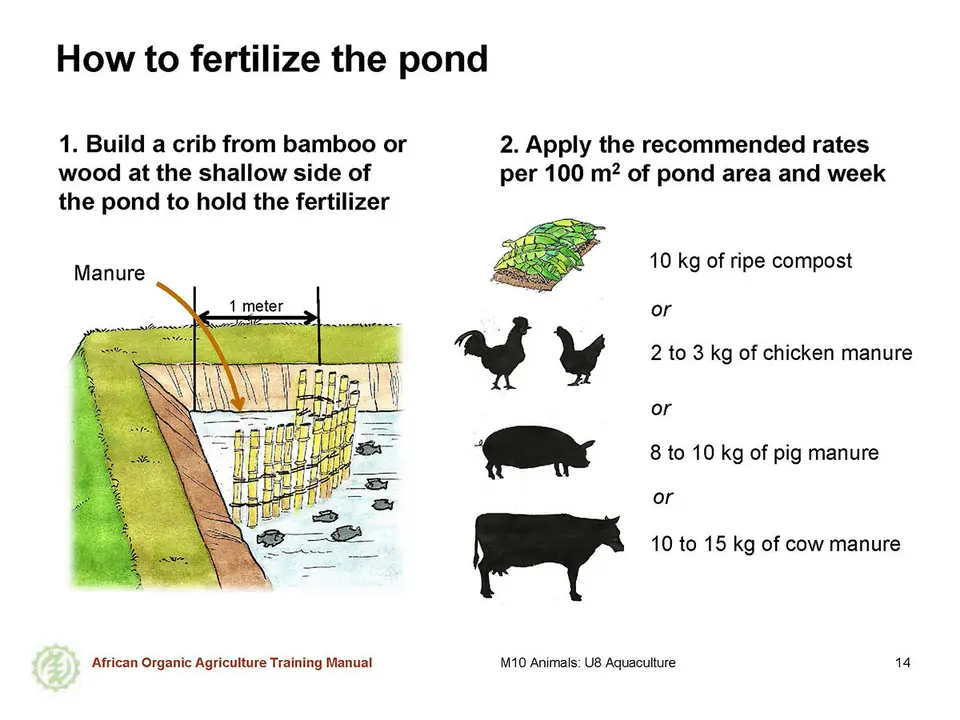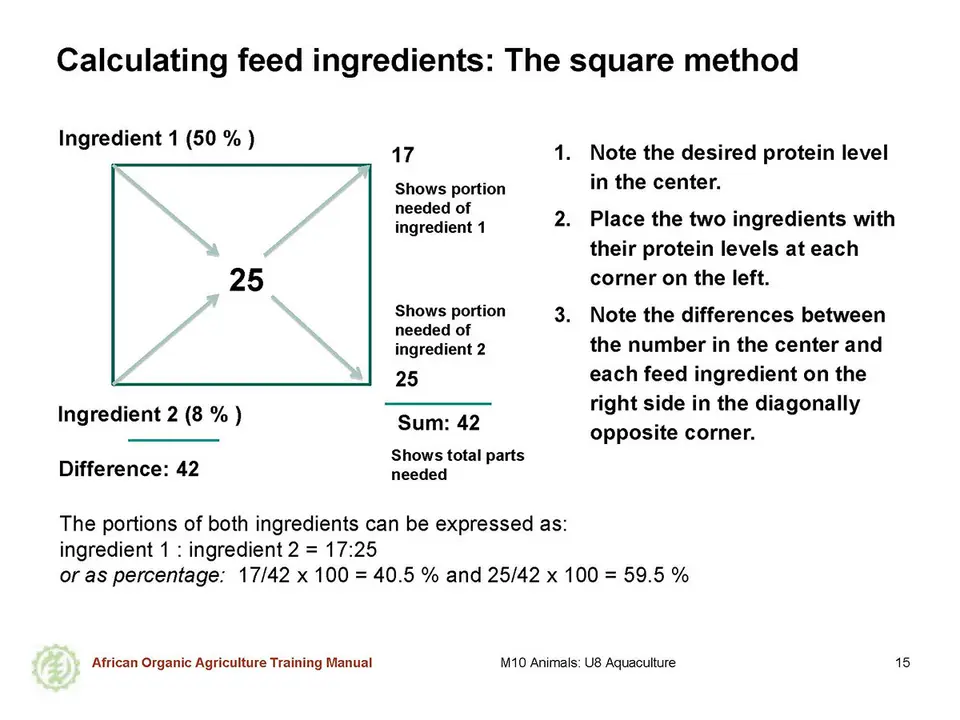Minimizing feeding costs
Feed is one of the most important factors influencing the growth and health of the fish. Minimizing feeding costs is thus of great interest, while ensuring sufficient good quality feed to ensure appropriate growth and good health of the fish. Tilapias can basically be fed by fertilizing the pond with animal manure or plant materials and encouraging the development of microalgae and other microorganisms in the water. Appropriate growth of microalgae and other microorganisms offers a valuable source of feed and results in increased fish yield. This is why integration of aquaculture with other animal keeping activities is quite popular in the tropics. It also helps to reduce the feeding costs considerably. To fertilize the ponds, manure from cattle, pig or poultry are used to either fertilize the bottom of the ponds prior to filling or to enrich the pond water with nutrients by continuously adding manure to the water. Based on pond manuring, the fish yield can be estimated to about 30 to 50 kilograms per 100 m² per year.
Feeding artificial feeds (including fishmeal or fish oil) could make the fish grow faster, but these feeds are expensive and may be difficult to purchase in organic quality (in case of organic certification).
a. Fertilizing the pond through integration of animal keeping
Keeping waterfowl is an uncomplicated and natural way of manuring the pond. Ducks and geese are attractive and especially suited fowl for small-scale farmers. Within one year about 120 to 150 ducks can be raised on 100 m² of pond with one growth cycle of the ducks being 2 months. During this period the ducks produce approximately 4 to 6 tons of manure. The birds can be fed on water hyacinth, cereal by-products, kitchen wastes or other vegetal feed. To balance fish and duck husbandry, the fish to duck ratio should be about 200 to 20 or 30 per 100 m²; and if geese are kept, 10 to 20 animals are ideal with 200 fish per 100 m².
Animal manure from cattle, pigs or poultry can be added to the pond directly, but because of hygienic reasons, previous composting is recommended. Staggered preparation of compost on separate piles offers the possibility of continuous fertilization of the pond.
Manuring of the pond should be done regularly with small amounts, instead of throwing a big amount of manure into the pond once a month. This is essential to avoid depletion of oxygen in the pond water. The best time to add manure is one or two hours after the morning feeding. Manuring after sunset must be avoided to prevent oxygen depletion due to combined oxygen consumption by algae in the dark and oxygen consumption by bacteria and fish. The site of manuring should be different from the feeding location.
b. Feeding the fish through integration of plant production
Alternatively to or in addition to adding manure to the pond, materials of plant origin can be used to feed the fish on a low production intensity level. Farm-own vegetal feeds include leftovers from fruits such as papaya or mango. Leaves and other vegetal material are best used to prepare compost with animal manure. In case fish production is certified as organic all external inputs must come from an organically certified farm. The leftovers from processing cereals and soybeans, etc. can either be added to the pond directly, which is much better, or they are processed to pellets.
There is a variety of plants that can be used for additional fish feeding. Some examples include rice bran, soy press cake, sunflower press cake, cassava leaves and roots, sorghum remains after pounding and maize (corn) milling remains.
When feeding the fish with plant material, attention must be paid not to spoil the pond water with too much plant material. Plant material which is not eaten by the fish directly or within a short time, will increase microalgae production and increase turbidity of the water. Fish farmers thus must keep a constant eye on water turbidity and the behaviour of the fish.
Homemade feeds
Remains and by-products from foodstuffs such as rice bran and soy press cake and other ingredients such as macroalgae must be dried, grained and stored separately, to avoid rapid spoilage due to high fat content. To produce the fish feed, a blend of all meals must be carefully mixed with water to get a paste that could be processed to pellets in a simple pellet press. The mixture of the different meals must contain approximately 1/3 cassava meal to obtain good water stability after drying the pellets in the sun. The mixture of the ingredients must also have a high protein content of 25 to 30 % or more. With the square method the ratio of two different ingredients with known protein contents can be calculated easily.
If farm-own inputs are not available to make the pellets, farmers can rely on the pond’s own production (and support it with fertilizing inputs or food leftovers from neighbouring farmers, if available) or they can use commercial compound feed. Commercial feed should be a tilapia-suitable feed with low or no fishmeal content. If farmers aim to sell their fish as organic at a regional market, then they must use an organically certified feed, which might be difficult to obtain. If they have the possibility to cooperate with a fish-feed producer, they can try to get a compound feed that complies with organic requirements. Such feed must be composed of GMO-free raw materials that has not been treated with pesticides, fungicides or the like and produced in accordance with organic regulations. Compound feeds have the advantage that they are more easily digested and healthier than most of the homemade feeds or feed made from a single by-product (e.g. rice bran). The cost of such feed is higher, but the result of the farm (the volume of the annual harvest) might get much better.
How to calculate feed requirements?
By knowing the number of fingerlings that are stocked to a pond, the farmer can calculate the fish biomass in the pond at a certain time, based on the average weight of the fish. Such monitoring is important to determine the correct amount of feed needed for the fish. For example, 5 % of the bodyweight in feed makes 4 kg of feed at the beginning of the growing period (calculating on base of 4,000 fingerlings of 20 g each) and about 55 kg at the end of the growing period (calculating with 3,600 adult fish of 300 g each). During the growing period of approximately eight to ten months, this increase in body weight and feed requirement is not linear, but follows a curve that could be determined by frequently weighing the fish.


 tap and then scroll down to the Add to Home Screen command.
tap and then scroll down to the Add to Home Screen command.